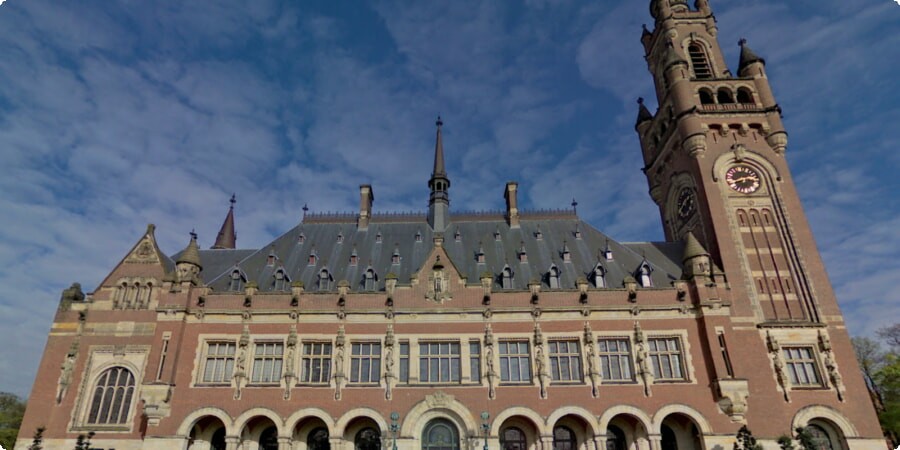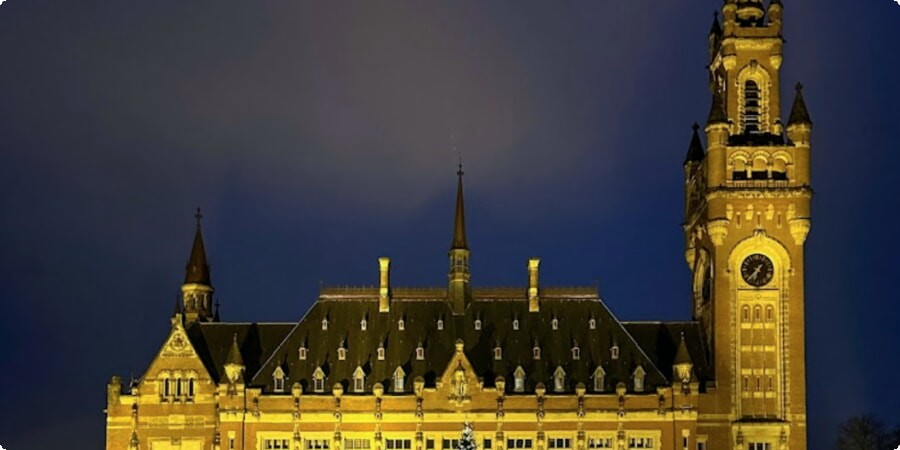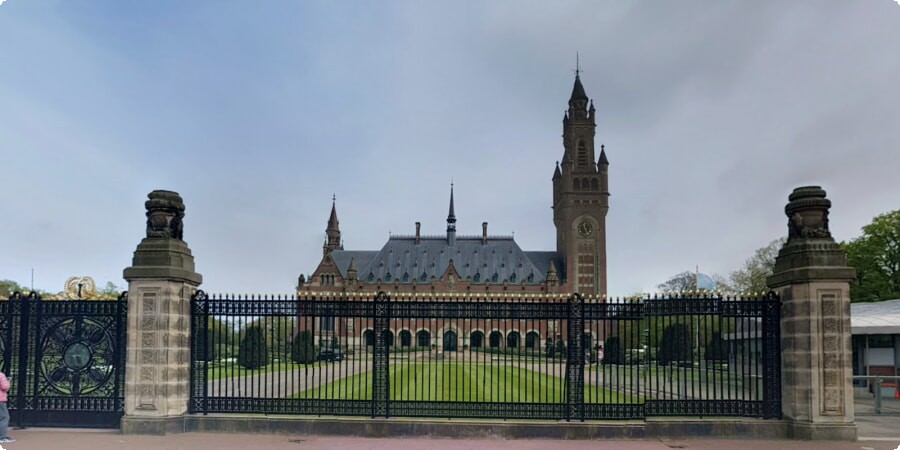Inside the Peace Palace: A Tour of the International Court of Justice
Nestled in the heart of The Hague, the Peace Palace stands as a symbol of justice, peace, and international law. This magnificent building is home to the International Court of Justice (ICJ), the principal judicial organ of the United Nations. The Peace Palace is more than just a stunning architectural masterpiece; it is a beacon of hope where global disputes are resolved, and international law is upheld.
In this article, we will take you on a tour inside the Peace Palace, exploring its rich history, architectural splendor, and the pivotal role it plays in promoting global justice. Whether you're a history buff, a law student, or simply curious about international relations, this tour will offer a deep dive into one of the most significant institutions in the world.
Historical Background of the Peace Palace
The Peace Palace's history dates back to the early 20th century, a time when the world was grappling with the aftermath of wars and conflicts. The idea of establishing a permanent court for international arbitration was championed by Andrew Carnegie, a philanthropist who believed in the power of law to maintain peace. Carnegie generously funded the construction of the Peace Palace, which was completed in 1913.
The Peace Palace was initially home to the Permanent Court of Arbitration, established to resolve disputes between states peacefully. Over time, it became the seat of the International Court of Justice, which was established in 1945 following the end of World War II. The ICJ plays a crucial role in adjudicating disputes between states and providing advisory opinions on legal questions referred to it by international organizations.
The Peace Palace has witnessed numerous historic milestones, including landmark cases that have shaped international law. Its corridors echo with the footsteps of diplomats, lawyers, and judges who have walked through its halls in the pursuit of justice.
For a detailed history of the Peace Palace, visit the Wikipedia page.
Architectural Highlights of the Peace Palace
The Peace Palace is not only a hub of legal activity but also an architectural gem. Designed by French architect Louis M. Cordonnier, the building combines Gothic and Renaissance styles, creating a harmonious blend of grandeur and elegance. The exterior of the palace is adorned with intricate carvings, statues, and symbolic motifs that reflect its purpose and mission.
One of the most striking features of the Peace Palace is its clock tower, which rises majestically above the building. The tower's design is inspired by medieval European architecture and serves as a symbol of timeless justice. The main entrance is flanked by two impressive bronze doors, each weighing over a ton and decorated with allegorical figures representing peace and justice.

Inside, the Peace Palace is equally breathtaking. The Great Hall of Justice, where the ICJ holds its sessions, is a magnificent space with high ceilings, stained glass windows, and murals depicting the history of law and justice. The hall's grandeur is complemented by its solemn atmosphere, befitting the gravity of the decisions made within its walls.
Throughout the palace, visitors will find numerous works of art, including tapestries, paintings, and sculptures donated by various countries. Each piece reflects the international spirit of the Peace Palace and the shared commitment to justice and peace.
Explore the architectural highlights of the Peace Palace on Google Maps.
If you're planning a visit to the Peace Palace, renting a car from Schiphol Airport can provide you with the flexibility to explore The Hague and its surroundings at your own pace. For convenient car rental options, visit this link.
Inside the Courtrooms
Stepping into the courtrooms of the Peace Palace is like entering the heart of international law and justice. These rooms are where the International Court of Justice (ICJ) conducts its proceedings, deliberating on some of the most pressing legal disputes between nations.
Layout and Design: The courtrooms are designed to reflect the gravity and dignity of the judicial process. The main courtroom, where public hearings are held, features high ceilings, large windows, and a grand bench where the judges sit. The room is equipped with modern technology to facilitate the proceedings, including translation services for the multiple languages spoken during cases.
Key Cases and Historical Trials: The ICJ has presided over numerous landmark cases since its establishment. These cases often involve complex issues such as territorial disputes, maritime boundaries, and human rights violations. Notable cases include the Corfu Channel case, which set important precedents in international maritime law, and the advisory opinion on the legality of the threat or use of nuclear weapons.
Role of Judges and Legal Proceedings: The judges of the ICJ, elected by the United Nations General Assembly and Security Council, represent a diverse range of legal traditions and cultures. Their role is to provide impartial and authoritative judgments based on international law. During hearings, both parties present their arguments and evidence, followed by deliberations among the judges. The decisions made in these courtrooms have far-reaching implications for international relations and the rule of law.
For a closer look at the courtrooms and the cases heard at the Peace Palace, consider booking a guided tour. These tours offer a unique opportunity to witness the ICJ in action and learn more about its pivotal role in global governance.

The Peace Palace Library
The Peace Palace Library is one of the most prestigious libraries in the world, specializing in international law. Established alongside the Peace Palace in 1913, the library serves as a vital resource for judges, lawyers, and scholars engaged in the study and practice of international law.
Overview of the Library's Collection and Resources: The library boasts an extensive collection of books, journals, and legal documents covering a wide range of topics related to international law. Its holdings include rare and historical texts, official publications of international organizations, and comprehensive legal databases. The library's catalog is continuously updated to include the latest legal scholarship and developments.
Importance for Legal Research and International Law: The Peace Palace Library is an indispensable tool for legal research. It provides access to primary and secondary sources that are crucial for understanding and interpreting international law. Researchers from around the world visit the library to conduct in-depth studies and gain insights into complex legal issues. The library also offers various services, including research assistance and interlibrary loans, to support the global legal community.
Noteworthy Collections and Rare Books: Among the library's treasures are rare manuscripts and early editions of foundational legal texts. These include works by prominent legal scholars and documents that have shaped the evolution of international law. The library also houses special collections on topics such as human rights, environmental law, and maritime law, making it a rich repository of legal knowledge.
To explore the resources available at the Peace Palace Library, visit the Wikipedia page for more information.
Art and Artifacts in the Peace Palace
The Peace Palace is not only a center of legal activity but also a museum of art and culture. Its halls are adorned with a remarkable collection of artworks and artifacts donated by various countries, each piece contributing to the palace's unique character and international spirit.
Significant Artworks and Their Meanings: The Peace Palace features an array of significant artworks, including paintings, sculptures, and tapestries. One of the most notable pieces is the "Peace Through Law" mural, which depicts the triumph of justice over war and conflict. This mural, along with many other artworks in the palace, serves as a visual representation of the ideals of peace and justice that the ICJ upholds.

Cultural Artifacts and Gifts from Around the World: Countries from all over the globe have contributed cultural artifacts and gifts to the Peace Palace, reflecting their support for international law and cooperation. These gifts include intricate vases from China, statues from Japan, and ceremonial swords from various nations. Each artifact tells a story of cultural heritage and the shared commitment to global peace.
How Art and Culture Influence the Atmosphere of the Peace Palace: The presence of art and cultural artifacts within the Peace Palace enhances its atmosphere, creating a space that is both inspiring and contemplative. The artworks and artifacts not only beautify the palace but also remind visitors and occupants of the universal values that unite different cultures in the pursuit of justice.
To fully appreciate the art and artifacts of the Peace Palace, visitors can join guided tours that highlight these treasures and explain their significance. If you're planning to explore more of the Netherlands and its cultural landmarks, consider renting a car for greater convenience and flexibility. For car rental options, visit this link.
Visitor Information and Tips
Visiting the Peace Palace is a must for anyone interested in international law, history, or architecture. To make the most of your visit, here are some essential tips and information:
Getting There: The Peace Palace is located in The Hague, easily accessible by public transportation. If you’re coming from Amsterdam, the train to The Hague Central Station is a convenient option. From the station, the Peace Palace is a short tram or bus ride away. For those driving, there are several parking options nearby.
Opening Hours and Tours: The Peace Palace is open to visitors year-round, but the best way to explore its interiors and learn about its history is through guided tours. These tours often include access to the Great Hall of Justice, the Peace Palace Library, and the various art collections. It's advisable to book your tour in advance as slots can fill up quickly.
Security Measures: Given its status as an active seat of international law, the Peace Palace has stringent security measures in place. Be prepared for security checks at the entrance, and avoid bringing large bags. Photography is usually restricted inside, so be sure to check the guidelines before your visit.
Nearby Attractions: While in The Hague, you can also visit nearby attractions such as the Mauritshuis Museum, home to works by Vermeer and Rembrandt, and the Binnenhof, the historic center of Dutch politics. The Hague’s blend of cultural and political landmarks makes it a fascinating city to explore.
Dining and Shopping: The area around the Peace Palace offers a variety of dining options, from casual cafes to fine dining restaurants. You’ll also find numerous shops and boutiques where you can purchase unique souvenirs to remember your visit.

Binnenhof in Modern Politics
While the Peace Palace stands as a monument to international law and justice, it also plays a dynamic role in contemporary global politics. The International Court of Justice (ICJ) housed within its walls is the principal judicial organ of the United Nations, making the Peace Palace a vital center for resolving international disputes.
The Court’s Role in Global Governance: The ICJ is tasked with adjudicating legal disputes between states and providing advisory opinions on legal questions referred to it by UN organs and specialized agencies. Its decisions and advisory opinions contribute significantly to the development of international law and the peaceful resolution of conflicts.
Recent Landmark Cases: In recent years, the ICJ has dealt with various high-profile cases, ranging from territorial disputes and maritime boundaries to human rights issues. These cases often involve complex legal principles and require the court to interpret international treaties and customary international law. The outcomes of these cases have far-reaching implications for the countries involved and the broader international community.
Diplomatic Engagements and Initiatives: The Peace Palace frequently hosts diplomatic events, conferences, and seminars aimed at promoting dialogue and cooperation among nations. These gatherings provide a platform for states to discuss pressing global issues and seek collaborative solutions. The palace’s serene and inspiring environment makes it an ideal venue for such important diplomatic engagements.
Preserving and Promoting Peace: Beyond its judicial functions, the Peace Palace symbolizes the global commitment to peace and justice. It serves as a reminder of the importance of international cooperation and the rule of law in maintaining global stability. The presence of the ICJ in the Peace Palace underscores the Netherlands’ dedication to supporting international legal institutions and fostering a peaceful world order.
For those who wish to delve deeper into the workings of the ICJ and its impact on international relations, visiting the Peace Palace offers a unique and insightful experience.
As we conclude our exploration of the Peace Palace, it's clear that this remarkable institution is much more than an architectural marvel. It is a living embodiment of the principles of justice, peace, and international law. From its historic beginnings to its modern role in global governance, the Peace Palace continues to be a beacon of hope and a testament to humanity’s enduring quest for a just and peaceful world.
Visiting the Peace Palace provides a profound understanding of the intricate relationship between law and global harmony. Whether you’re exploring its majestic halls, delving into its extensive library, or marveling at its art collections, the Peace Palace offers a rich and multifaceted experience.
For those planning a visit to the Netherlands, renting a car can provide the freedom to explore not just The Hague but also other historic and cultural sites across the country. For convenient car rental options, visit this link.
The Peace Palace stands as a symbol of our collective aspirations for a better world, where justice prevails, and peace is maintained. It invites visitors to reflect on the past, engage with the present, and be inspired for the future.